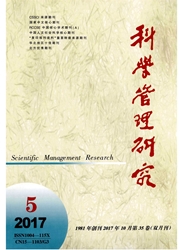

 中文摘要:
中文摘要:
Dairy industry has become an increasingly important enterprise in China as people’s dietary preferences and composition have changed dramatically with rapid economic development in the past several decades.A number of problems,however,exist in China’s relatively young dairy industry,including the imbalanced allocation of profits throughout the dairy supply chain.One of the root causes of the melamine infant powered milk scandal in 2008 was the unfair profit allocation mechanism in dairy supply chain.The revenue sharing contract approach has proven to be effective in generating market shares and total profits.In this study,we apply the three-stage revenue sharing contract model of Giannoccaro and Pontrandolfo(2004)in an analysis of dairy supply chain to explore its problems in profit allocation and possible solutions to them.The analysis was conducted by a case study of Hohhot,often called as"milk capital of China".Our results show that the current profit distribution in the dairy supply chain is not balanced:the supermarket’s profit>farmer’s profit>manufacturer’s profit.Under the revenue sharing contract setting,the dairy industry’s total profit increased by 12.49%.By exploring different parameters in the revenue sharing contract model,we have found that a win-win situation can be created among all the members of the supply chain.In dairy supply chain,the ratio of the revenue reserved for the supermarket itself is equal or greater than 47%and the ratio of the revenue reserved for the manufacturer itself is between 46.4 and 50.2%.The values of the parameters that generate a sustainable or win-win situation are related to the bargaining position in the dairy supply chain.The revenue sharing contract has proven to be effective and desirable by all the dairy chain partners in dairy supply chain.The results of this study provide relevant information for improving the dairy supply chain structure and the revenue sharing contract model can be applied to other industries,sectors and regions.
 英文摘要:
英文摘要:
Dairy industry has become an increasingly important enterprise in China as people's dietary preferences and composition have changed dramatically with rapid economic development in the past several decades.A number of problems,however,exist in China's relatively young dairy industry,including the imbalanced allocation of profits throughout the dairy supply chain.One of the root causes of the melamine infant powered milk scandal in 2008 was the unfair profit allocation mechanism in dairy supply chain.The revenue sharing contract approach has proven to be effective in generating market shares and total profits.In this study,we apply the three-stage revenue sharing contract model of Giannoccaro and Pontrandolfo(2004) in an analysis of dairy supply chain to explore its problems in profit allocation and possible solutions to them.The analysis was conducted by a case study of Hohhot,often called as "milk capital of China".Our results show that the current profit distribution in the dairy supply chain is not balanced:the supermarket's profitfarmer's profitmanufacturer's profit.Under the revenue sharing contract setting,the dairy industry's total profit increased by 12.49%.By exploring different parameters in the revenue sharing contract model,we have found that a win-win situation can be created among all the members of the supply chain.In dairy supply chain,the ratio of the revenue reserved for the supermarket itself is equal or greater than 47% and the ratio of the revenue reserved for the manufacturer itself is between 46.4 and 50.2%.The values of the parameters that generate a sustainable or win-win situation are related to the bargaining position in the dairy supply chain.The revenue sharing contract has proven to be effective and desirable by all the dairy chain partners in dairy supply chain.The results of this study provide relevant information for improving the dairy supply chain structure and the revenue sharing contract model can be applied to other industries,sectors and regions.
 同期刊论文项目
同期刊论文项目
 同项目期刊论文
同项目期刊论文
 期刊信息
期刊信息
